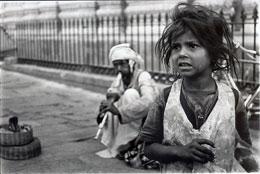Unwanted daughters India die young

Almost a quarter-of-a-million girls younger than five die in India every year due to neglect resulting from society's preference for sons, a gender discrimination study has found.
This was over and above those aborted simply for being female, researchers wrote in The Lancet medical journal.
"Gender-based discrimination towards girls doesn't simply prevent them from being born, it may also precipitate the death of those who are born," said study co-author Christophe Guilmoto of the Paris Descartes University.
"Gender equity is not only about rights to education, employment or political representation, it is also about caring, vaccination, and nutrition of girls, and ultimately survival."
Guilmoto and a team used population data from 46 countries to calculate how many infant girls would have died in a society where there was no discrimination impact, and how many died in reality.
The difference, about 19 deaths out of every 1,000 girls born between 2000 and 2005, was ascribed to the effects of gender bias.
This amounted to about 239,000 deaths per year or 2.4 million over a decade.
"Around 22 percent of the overall mortality burden of females under five (in India) is therefore due to gender bias," the International Institute for Applied Systems Analysis (IIASA) a research institute based in Austria, said in a statement.
The problem was most pronounced in northern India, the researchers found, with states like Uttar Pradesh, Bihar, Rajasthan, and Madhya Pradesh, accounting for two-thirds of the excess deaths.
Hardest hit were poor, rural, farming regions with low education levels, high population densities, and high birth rates.
"As the regional estimates of excess deaths of girls demonstrate, any intervention to reduce the discrimination against girls in food and healthcare allocation should, therefore, target in priority regions... where poverty, low social development, and patriarchal institutions persist and investments (in) girls are limited," said co-author Nandita Saikia of IIASA.
It is the first time that the number of excess deaths amongst girls under five in India was studied at the district level, showing specific geographic patterns of excess female mortality across India’s 640 districts.
The worst affected areas were all rural, agricultural areas with lower levels of education, high population densities, low socioeconomic development and high levels of fertility. The researchers said that many deaths of females under five are partly down to unwanted childbearing and subsequent neglect.
Higher levels of female literacy and employment in more modern industries were linked to lower levels of excess mortality in females under five.
“As the regional estimates of excess deaths of girls demonstrate, any intervention to reduce the discrimination against girls in food and healthcare allocation should, therefore, target in priority regions of Bihar and Uttar Pradesh where poverty, low social development, and patriarchal institutions persist and investments on girls are limited,” said Saikia.
Saikia added, “The sustained fertility decline currently observed in North India is likely to lead to a reduction in postnatal discrimination. Unless son preference diminishes, lower fertility, however, might bring about a rise in gender-biased sex selection as was observed 20 years ago in Western India. This reinforces the need to address directly the issue of gender discrimination in addition to encouraging social and economic development for its benefits on Indian women.”
Interestingly, the results did not coincide with areas with known skewed sex ratios at birth, such as Punjab, Gujarat, and Maharashtra. Co-researcher Christophe Guilmoto said that for too long, the focus was on prenatal sex selection.
“Gender-based discrimination towards girls doesn’t simply prevent them from being born, it may also precipitate the death of those who are born,” he said. “Gender equity is not only about rights to education, employment or political representation. It is also about care, vaccination, and nutrition of girls, and ultimately survival.”
Saikia noted that if there were no excess female deaths in India, the country could have achieved its Millennium Development Goal target on child mortality, of 42 deaths per 1,000 births, very easily.
“Discrimination towards the girl child is not justified. There is a need to change the mentality. Rather than discriminating against them, it is necessary to raise their value through education and self-dependence,” concluded Saikia.In all, 29 out of 35 states in India had overall excess mortality in girls under five, and all states and territories bar two had at least one district with excess mortality. However, the level varied.









